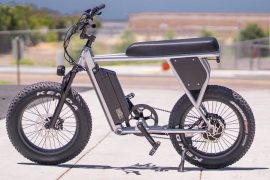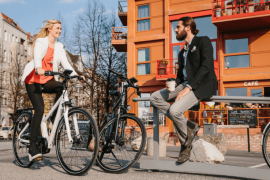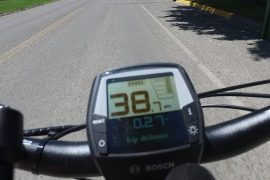As electric bicycles have become more popular in Europe, Asia and the Americas, different types of products have entered the space. Some could be considered “low-speed electric bikes” as defined by U.S. Public Law, while others are more closely related to mopeds or motorcycles based on their power and speed. For this reason, several “classes” were created in Europe defining how and where specific e-bikes could be used. Variations of these classes are now becoming relevant in America and other locales as laws are put in place determining whether and where an e-bike can be used on the road, bike paths and mountain biking trails.
Classes of Electric bikes
Class 1: Pedal Assist
The electric drive system on the e-bike can only be activated through a pedalling action and is limited to relatively low speeds. The sensor usually measures pedal movement, pedal torque or bicycle speed (sometimes all three) and sensors are located in the bottom bracket, rear hub or rear wheel. In parts of Europe this class is limited to 15 mph (25 kph) with motor wattage <= 250 watts. In America, because of our more liberal vehicle definition, this class is limited to a motor-powered speed of 20 mph (32 kph) with motor wattage of <= 750 watts. Due to the low speed of operation and required pedalling action this class should benefit from the same rights and access privileges as non-assist bicycles and should be able to be used on streets, bike lanes, multi-use bike paths and off-road trails.
Class 2: Throttle On Demand
The electric drive system on the e-bike can be activated through a throttle element such as a grip-twist, trigger or button and is limited to low speeds. The motor system may also be activated through a pedalling action as with Class 1. In parts of Europe, this class would be considered a motor vehicle and is prohibited from use on trails and other bicycle-specific infrastructure and is, therefore, less common. For those locations where it is allowed in Europe, the top speed is limited to 15 mph (25 kph) with motor wattage <= 250 watts as with Class 1. In America, this class is currently less restricted and therefore more common. The top speed is limited to 20 mph (32 kph) with motor wattage of <= 750 watts as with Class 1.
Due to the low speed of operation without the required pedalling action, this class may be a bit more restricted but still benefit from the same rights and access privileges on paved surfaces as non-assist bicycles and should be able to be used on streets, bike lanes and multi-use bike paths.

Class 3: Speed Pedelec
The electric drive system on the e-bike can be activated through a pedalling action to reach higher top speeds. In parts of Europe this class is also considered a motor vehicle and requires special licensing, the use of an identification plate at the rear of the bike may be required and use is limited to roads or private property only with a maximum speed ~28 mph (~45 kph). In America, this class could still be considered a “low-speed electric bicycle” if human power propels the bike above 20 mph and as such, does not require special licensing but maybe even more restricted to roads, adjacent bike lanes or on private property with a maximum speed ~28 mph (~45 kph) and motor wattage of <= 750 watts.
In America, this class is often combined with Class 2 which produces bikes that have a throttle element capable of powering the rider up to 20 mph (32 kph) on motor power only, as well as a pedal-assist mechanism capable of powering the rider up to 28 mph (45 kph). In parts of Europe, where throttles are less common, most Class 3 electric bikes only offer pedal assist.
Class 4: Moped or Motorcycle
The electric drive system can be activated through a pedalling action or throttle. The top speed is above 28 mph (45 kph) and/or the motor wattage may be greater than 750 watts. In all major geographies, this class would be considered a motor vehicle which requires licensing and registration and is limited to certain motorized off-road trails or traditional roads. There has been some confusion in America where machines that resemble bicycles (having pedals) that are capable of high speed and power are used inappropriately without licensing or insurance and on infrastructure reserved for bicycles such as paths and mountain bike trails. This behaviour is subject to the same legal action as driving a gas-powered motorcycle or car and may result in severe legal ramifications.
The value of these classes and a key takeaway for the U.S. market is that the PL 107-319 law categorizes e-bikes with <= 750 watts of power and top speeds of <= 20mph as bicycles. It does not determine where this class can be used, however. In the U.S., use is determined at the State or Local level, sometimes in the vehicle code section of the law. By introducing classes, specifically the first three classes above, cities and states can help guide use for e-bikes. These classes are being established in the U.S. by the BPSA (Bicycle Products Suppliers Association) using a special Electric Bike Committee and are being modelled on what has worked in Europe.
The BPSA committee is working directly with e-bike manufacturers and suppliers for buy-in and is creating model legislation to guide States. This is why these classes are also being listed here at ElectricBikeReview.com to help consumers understand what they mean and how they apply to bikes for sale. You can check the Best Electric Bicycles under £1000 all class e-bikes are included in it. The goal is to create some consistency in the e-bike space so that one type of low-speed electric bike could be used on paths or trails in multiple geographies across the world.




